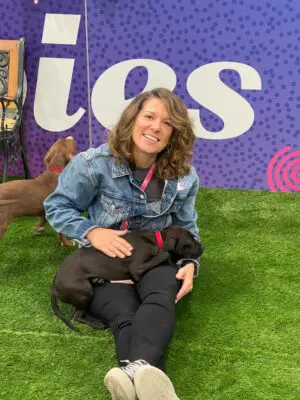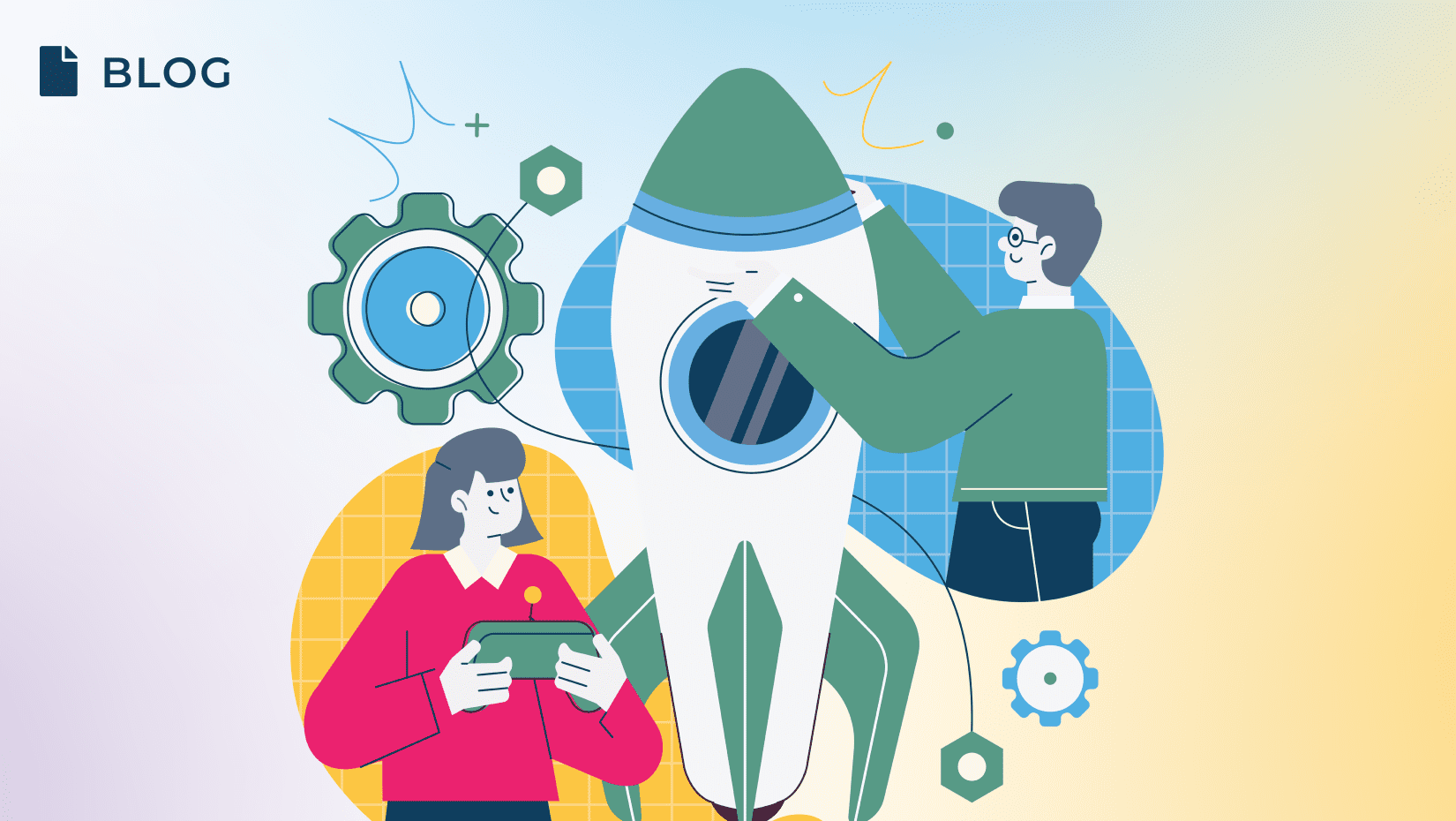Thousands of customer education, customer success, community, and product pros shuffled through the doors of St. Louis’ America’s Center for two unforgettable days filled with learning, networking…and puppies.

Denise Stokowski (SVP, Product Management, Gainsight) with the Puppies of Pulse
This year’s Pulse also featured a first—a dedicated track on digital customer education with a simple goal: Provide attendees with actionable insights and takeaways they could apply to their program.
Now, I want to share my biggest takeaways from every session and what I think they mean for the future of digital customer education.
I will warn you, though, there’s a lot here, so buckle up, grab some popcorn, and dive in.
Session: Human-Centered Education—HubSpot’s Winning Formula for Customer Success
Courtney Sembler, Director of the HubSpot Academy
If you’ve never met Courney Sembler, allow me to virtually introduce you. With nearly a decade at HubSpot in a variety of roles, Courtney now serves as the Director of HubSpot Academy.
Her mission? Create a global learning community through content, experiences, and credentials that help HubSpot increase product adoption, maximize career potential, and expand HubSpot’s market reach—and it’s safe to say she’s accomplished that.
She’s a digital customer education rockstar in every sense, so I was understandably excited for her session that dove into HubSpot’s winning formula.

Watch Courtney’s On-demand Session
My Key Takeaway: Digital First; Human-Created
The rapid advancement of artificial intelligence (AI) continues to spur conversations about humanity’s future—and rightfully so. People are asking, “Will AI take my job?” and “What impact will the robots have on how we interact with other people?” As a Product Marketer at Gainsight, I’m asking questions like:
- How can we use AI to better personalize the learning experience?
- How will AI create efficiencies for Customer Education teams and Customer Success Managers (CSMs)?
- What new opportunities will AI create for retaining customers?
But most importantly, I’m asking myself: How can we integrate AI—and other technology—into Gainsight CE that aligns with our human-first approach to learning?
Although Courtney didn’t address that question directly, her message was the same: Today’s customer education programs are driven by technology, but they must maintain a human touch. While technology, like learning management systems (LMS), power many programs and introduce efficiencies, we can’t forget that the person on the other side of the screen is…human.
Courtney said, “When we sit down to create customer education and use AI [and other technology] to do so, we’re crafting a digital experience, but we’re doing so for humans.” She continued, “We can’t leave them out of the conversation. We can’t say we’re doing it for just ROI. We’re still impacting that human at the end of the day.”
At the end of the day, the future of customer education is digital, but the worst thing we can do is lose sight of the fact that our customers are people, too, and your program is for them.
Session: Expanding the CS Playbook: Using CE as a Core Strategy for CS
Dave Derington, CEO, Software Education Solutions, LLC; Lila Krutel Meyer, Director, Global Education Services, Gainsight
“What does customer success mean to you?” This was the opening question from Dave at the beginning of his presentation with Lila—and the audience’s responses echoed key themes: Strategic advisory, proactive outreach, relationships, empowerment, and achieving outcomes.
I hope we can agree that these concepts are at the heart of modern customer success. But asking your CSMs and other customer-facing teams to drive retention, adoption, and be strategic advisors across dozens, maybe even hundreds of accounts is anything but easy.
This is where digital customer education comes into play and what Dave and Lila talked about during their session. Chatting further with Dave after the session, he encapsulated the essence of their discussion perfectly: “Empowering customers through education is empowering our teams. It reduces the burden on our CSMs and allows them to focus on what they do best—building relationships and driving success for our customers.”
Watch Dave and Lila’s On-demand Session
My Key Takeaway: Customer Education Is All About Empowerment
It’s time for companies to stop thinking about customer education as a supplementary tactic, but as a core component of their customer success strategy that empowers customer-facing teams to overcome the hurdles and inefficiencies holding them back from increasing engagement, product adoption, and retention.
Lila’s 3-step process can help you do that:
- Identify the challenges holding your CS team back
- Quantify those challenges and prioritize based on impact
- Weave digital customer education into your CS playbook
For example, if your CSMs are struggling to onboard a growing customer base, weave personalized learning paths and automated emails with relevant course links into the onboarding process to reduce the burden on CSMs and free them up to proactively support more customers.
Session: Product Training vs. Customer Education: Why the Transition Is Critical for Customer Success
Debbie Smith, Sr. Director Visier University & President @ CEdMA
Traditional “how-to” product education, i.e., the monolithic formats that show customers how to use every button on every screen, isn’t what customer education is meant for (leave that to the support documents). Instead, they need value-driven education that focuses on the outcomes and metrics that actually matter, like annual contract value, customer lifetime value (CLTV), and gross retention revenue (GRR).
Debbie covered this, and more, during her presentation, helping attendees shift their mindset and reframe their conversations with internal stakeholders.

Watch Debbie’s On-demand Session
My Key Takeaway: Customer Outcomes > Product Features
“Product education is its traditional format focused on the product,” Debbie said during her session. “We’ve historically taught our customers every click and feature, even if they never used it.” She continued, “Customer education must guide customers to value versus educating them on every feature.”
What does that look like in practice? Instead of teaching customers how to navigate a new dashboard feature or report in your analytics suite, focus on teaching them how the dashboard can enhance their ability to make faster, more data-driven decisions. Said another way, shift your focus from the mechanics of features to the real-world benefits and outcomes.
Session: Updater’s Crawl, Walk, Run Approach to Customer Training and Product Adoption
Rupal Nishar, Head of Customer Success at Updater
Rupal’s journey to launch Updater’s Academy didn’t happen overnight; it was a marathon, not a sprint that was built around a crawl-walk-run methodology.
In Rupal’s session, she dove into her phased approach and how she tailored Updater’s customer education program for each stage of company growth—starting with a soft launch (crawl), optimizing with automation (walk), and expanding to meet the needs of a large-scale operation (run).
Watch Rupal’s On-demand Session
My Key Takeaway: Good Things Take Time
I get it. There are so many incredible academies out there, many of which you want to emulate from day one. That’s not possible for most teams, though. Instead, embrace a crawl-walk-run methodology that lays a sturdy foundation and builds based on feedback.
Here’s an example:
- Crawl: Start with a simple learning path that introduces your customers to core functionalities and gives you the ability to start collecting feedback.
- Walk: Expand your program by creating role-based courses that dive into product features and capabilities relevant to different subsets of your customer base.
- Run: Fully integrate learning into the customer lifecycle with automated emails and in-app guidance that ensures your customers have access to relevant content in their moment of need.
The outcome? A phased approach that prioritizes manageable growth and scales in a way that remains aligned with your customers’ needs and business goals.
Session: Harmonizing Digital and Human Touch in Customer Education
Karla Kannan, SVP of Customer Experience, BirchStreet Systems
The digital wave that transformed our personal lives—think Netflix, Amazon, and Spotify—is now sweeping the B2B world. Case in point: A growing number of businesses are using LMSs to power their digital customer education programs.
And the perks of this personal and professional revolution are impossible to ignore:
- Personalization: Tailored experiences to individual needs and preferences at scale
- Efficiency: Streamlined processes and time-savings
- Convenience: Simplified tasks and access to information
That said, as Karla highlighted in her presentation, human interaction is irreplaceable and true customer education requires a thoughtful balance of digital tools and human-led efforts to effectively cater to different learning styles and address the unique needs of every customer.
Watch Karla’s On-demand Session
My Key Takeaway: It All Starts By Understanding Your Customers
This was BY FAR my favorite slide from Karla’s session:

Why? Because it illustrated that despite the increasing digital world, companies are still leaning on onsite training. And while there’s a time and place for onsite training—like if you have an incredibly complex product—it often falls short of delivering the experience your customers need.
Karla said, “We assumed every customer would benefit from this onsite service. But what happens after we leave? They’re left without ongoing support and trying to remember where to click.”
On top of that, Karla noted that required onsite training simply couldn’t afford to block their calendars for extended training. So, she took a step back and asked herself what her customers, hospitality workers, need. Her answer: A fast and flexible alternative that allowed them to fit learning into their hectic and often unpredictable schedules.
The takeaway? We must understand what our customers need—and how they want to learn—and give them that. If onsite training is still in the mix? Great—it’s not the bad guy. But it misses the mark if it doesn’t align with customer preferences, lifestyles, and learning expectations.
Session: Lessons—and Mistakes—From a Decade of Customer Education Excellence
Chris Lodolce, SaaS Academy Program Advisor, SaaS Academy Advisors
But when Chris left HubSpot to help other companies start customer education programs, he quickly realized that HubSpot’s playbook didn’t work for everyone. Instead, every company needed to adapt and customize their own playbook for their needs and expectations of their customers.
Watch Chris’ On-demand Session
My Key Takeaway: There’s Not One Way to Do Customer Education
Say it with me: What worked for HubSpot might not be your magic formula—and that’s perfectly fine. While it’s ok to draw inspiration from HubSpot’s winning strategy, which Courtney outlined during her session, remember that the most successful customer education programs lie in their ability to adapt.
Every company and its customer has their own unique ecosystem influenced by environmental and cultural factors, which means your customer education program must be designed to be flexible and responsible to what that looks like for you.
So, instead of recycling strategies of your peers, take the time to customize your approach to your environment and customers.
Session: Making Every Interaction Count with Blended Digital Learning
Robin Raye, Director of Customer Education, Iodine Software
The modern customer expects educational experiences that are dynamic and comprehensive as the digital world itself. Iodine Software is at the forefront of this shift and transforming how customer success is achieved through innovative learning strategies that blend structured learning, engaging user communities, and intuitive in-app guidance.
Watch Robin’s On-demand Session
My Key Takeaway: Emphasize Practical Application
Robin presented five pivotal moments of learning needs in her session:
- Apply: When users need to act upon what they’ve learned
- Solve: When problems arise or things don’t work the way they intended
- Change: When users need to learn a new way of doing something
- New: When users are learning to do something for the first time
- More: When users are expanding the breadth and depth of their knowledge
She then asked the audience: “Which moment of need will give you the biggest bang for your buck in terms of learner performance?”
The answer: Apply—and it’s easy to see why.
By centering customer education programs around practical application via in-app guidance, engaging videos, and community engagement, your customers can better integrate new knowledge and skills into their daily workflows; it’s adult learning in its purest form.
Session: Future Proofing Your Customer Education Program For Unexpected Company Changes
K.C. Williams, Director, Education Products, Anthology, Inc.; Katie Felton, Director, Anthology Academy, Anthology, Inc.
What do you do when your company goes through a massive change? You adapt.
Change management is commonplace for companies big and small alike. Between mergers, acquisitions, and restructures, companies across the board will always face the challenge of adapting to change while ensuring customer success and satisfaction.
KC and Katie are well-versed in this reality as they navigated Anthology’s complex merger and confronted the challenges head-on, particularly from the perspective of their learning team and technology infrastructure. Most importantly, however, they demonstrated how digital customer education can not only mitigate disruptions caused by change, but also future-proof a company’s engaging strategy to ensure customers remain engaged, successful, and loyal throughout it all.
Watch K.C. and Katie’s On-demand Session
My Key Takeaway: Accept—and Embrace—the Change
Change is coming, so embrace it.
As mergers, acquisitions, and technological advancements reshape every corner of the business world, the ability to adapt quickly will be key. For customer education teams, that means designing programs that are resilient, responsive, and can maintain their efficacy despite sudden change.
How? Always put the end-user experience first. By doing so, you can ensure that educational content remains relevant, accessible, and effective.
My BIGGEST Takeaway from Pulse 2024
As I reflect on my time at Pulse, one takeaway stands above the rest: Customer education is customer success. Gone are the days when it was acceptable to view customer education as a siloed tactic that had few, if any, strings tying it back to other core company functions.
Today—and everyday in the future—customer education must act as a key component in overarching company strategies that empower both your teams and your customers.
Got Pulse FOMO? Join Us in Amsterdam
Pulse Europe is just around the corner! We’re thrilled to announce that Pulse Europe 2024 is taking place 13–14 November, 2024 at the RAI Amsterdam Convention Centre. Register before July 1st and get a second complimentary ticket to the conference.


